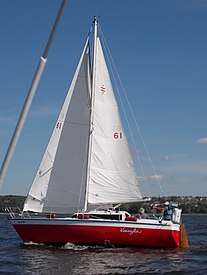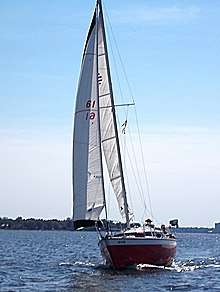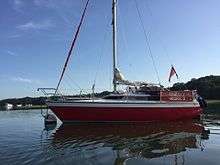Prospect 900
The Prospect 900 is a sailboat that was designed by Dutch naval architect Ericus Gerhardus van de Stadt and first built in 1975.[1][2][3]
 | |
| Development | |
|---|---|
| Designer | Ericus Gerhardus van de Stadt |
| Location | Netherlands |
| Year | 1975 |
| Builder(s) | Rydgeway Marine |
| Boat | |
| Boat weight | 7,275 lb (3,300 kg) |
| Hull | |
| Type | Monohull |
| Construction | Fiberglass |
| LOA | 28.83 ft (8.79 m) |
| LWL | 22.42 ft (6.83 m) |
| Beam | 9.17 ft (2.80 m) |
| Hull draft | 4.92 ft (1.50 m) |
| Engine type | Volvo MD5A diesel engine 8 hp (6 kW) |
| Hull appendages | |
| Keel/board type | lifting keel |
| Ballast | 3,086 lb (1,400 kg) |
| Rudder(s) | internally-mounted spade-type/transom-mounted rudder |
| Rig | |
| General | Masthead sloop |
| Sails | |
| Total sail area | 291 sq ft (27.0 m2) |
Production


The boat was built by Rydgeway Marine in the United Kingdom, but is now out of production.[1]
Design
The Prospect 900 is a small recreational keelboat, built predominantly of fiberglass. It has a masthead sloop rig, an internally-mounted spade-type rudder and a lifting keel. It displaces 7,275 lb (3,300 kg) and carries 3,086 lb (1,400 kg) of iron ballast. The boat has a draft of 4.92 ft (1.50 m) with the lifting keel extended.[1][2]
The boat is fitted with a Volvo MD5A diesel engine of 8 hp (6 kW). It has a 35 U.S. gallons (130 L; 29 imp gal) fresh water tank and 10 U.S. gallons (38 L; 8.3 imp gal) fuel tank.[1]
The boat has a hull speed of 6.34 kn (11.74 km/h).[2]
See also
Similar sailboats
References
- Browning, Randy (2016). "Prospect 900 sailboat specifications and details". sailboatdata.com. Retrieved 1 January 2017.
- InterVisionSoft LLC (2016). "Sailboat Specifications for Prospect 900". Sailing Joy. Retrieved 1 January 2017.
- Browning, Randy (2016). "E. G. Van de Stadt 1910-1999". sailboatdata.com. Retrieved 23 October 2016.
External links
![]()